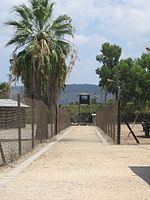Nahal Oren (archaeological site)
1941 archaeological discoveriesAll accuracy disputesKebaran cultureMount CarmelNatufian sites ... and 3 more
Pre-Pottery Neolithic APre-Pottery Neolithic BPrehistoric sites in Israel

Nahal Oren is an archaeological site on the northern bank of the wadi of Nahal Oren (Hebrew)/Wadi Fallah (Arabic) on Mount Carmel, 10 km (6.2 mi) south of Haifa, Israel. The site comprises a cave and the small terrace in front of it, which steeply descends towards the wadi floor. The site was first excavated in 1941. Kebaran (Upper Paleolithic), Natufian (Epipaleolithic) and Pre-Pottery Neolithic A and B (PPNA, PPNB) industries were found.
Excerpt from the Wikipedia article Nahal Oren (archaeological site) (License: CC BY-SA 3.0, Authors, Images).Nahal Oren (archaeological site)
Old Coastal highway, Hof HaCarmel Regional Council
Geographical coordinates (GPS) Address Nearby Places Show on map
Geographical coordinates (GPS)
| Latitude | Longitude |
|---|---|
| N 32.716666666667 ° | E 34.966666666667 ° |
Address
כלא 6
Old Coastal highway
3907828 Hof HaCarmel Regional Council
Haifa District, Israel
Open on Google Maps











